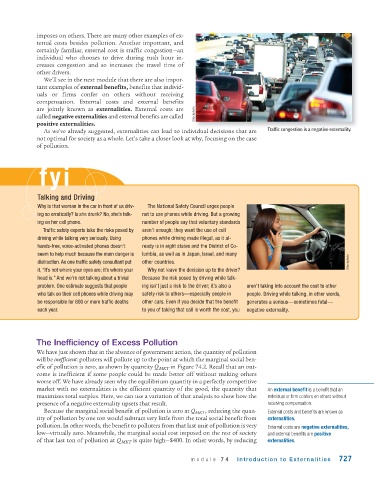Page 769 - Krugmans Economics for AP Text Book_Neat
P. 769
imposes on others. There are many other examples of ex-
ternal costs besides pollution. Another important, and
certainly familiar, external cost is traffic congestion—an
individual who chooses to drive during rush hour in-
creases congestion and so increases the travel time of
other drivers.
We’ll see in the next module that there are also impor-
tant examples of external benefits, benefits that individ-
uals or firms confer on others without receiving
compensation. External costs and external benefits
are jointly known as externalities. External costs are
called negative externalities and external benefits are called iStockphoto
positive externalities.
As we’ve already suggested, externalities can lead to individual decisions that are Traffic congestion is a negative externality.
not optimal for society as a whole. Let’s take a closer look at why, focusing on the case
of pollution.
fyi
Talking and Driving
Why is that woman in the car in front of us driv- The National Safety Council urges people
ing so erratically? Is she drunk? No, she’s talk- not to use phones while driving. But a growing
ing on her cell phone. number of people say that voluntary standards
Traffic safety experts take the risks posed by aren’t enough; they want the use of cell
driving while talking very seriously. Using phones while driving made illegal, as it al-
hands-free, voice-activated phones doesn’t ready is in eight states and the District of Co-
seem to help much because the main danger is lumbia, as well as in Japan, Israel, and many
distraction. As one traffic safety consultant put other countries. iStockphoto
it, “It’s not where your eyes are; it’s where your Why not leave the decision up to the driver?
head is.” And we’re not talking about a trivial Because the risk posed by driving while talk-
problem. One estimate suggests that people ing isn’t just a risk to the driver; it’s also a aren’t taking into account the cost to other
who talk on their cell phones while driving may safety risk to others—especially people in people. Driving while talking, in other words,
be responsible for 600 or more traffic deaths other cars. Even if you decide that the benefit generates a serious—sometimes fatal—
each year. to you of taking that call is worth the cost, you negative externality.
The Inefficiency of Excess Pollution
We have just shown that in the absence of government action, the quantity of pollution
will be inefficient: polluters will pollute up to the point at which the marginal social ben-
efit of pollution is zero, as shown by quantity Q MKT in Figure 74.2. Recall that an out-
come is inefficient if some people could be made better off without making others
worse off. We have already seen why the equilibrium quantity in a perfectly competitive
market with no externalities is the efficient quantity of the good, the quantity that An external benefit is a benefit that an
maximizes total surplus. Here, we can use a variation of that analysis to show how the individual or firm confers on others without
presence of a negative externality upsets that result. receiving compensation.
Because the marginal social benefit of pollution is zero at Q MKT , reducing the quan- External costs and benefits are known as
tity of pollution by one ton would subtract very little from the total social benefit from externalities.
pollution. In other words, the benefit to polluters from that last unit of pollution is very External costs are negative externalities,
low—virtually zero. Meanwhile, the marginal social cost imposed on the rest of society and external benefits are positive
of that last ton of pollution at Q MKT is quite high—$400. In other words, by reducing externalities.
module 74 Introduction to Exter nalities 727

